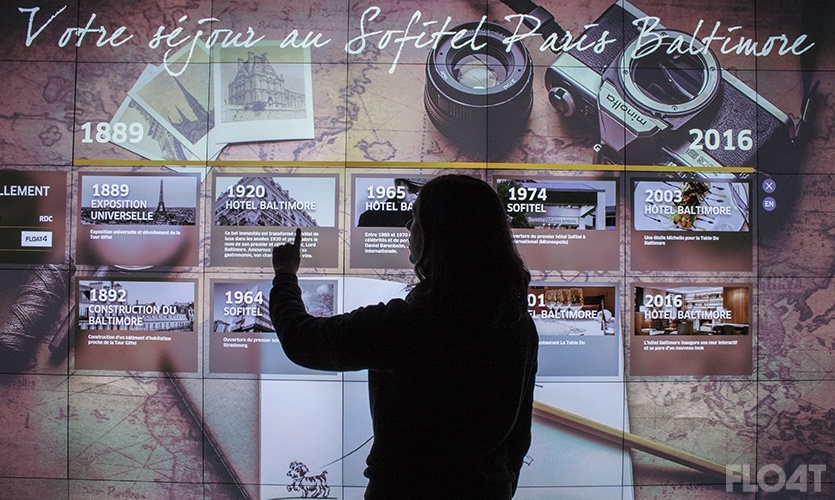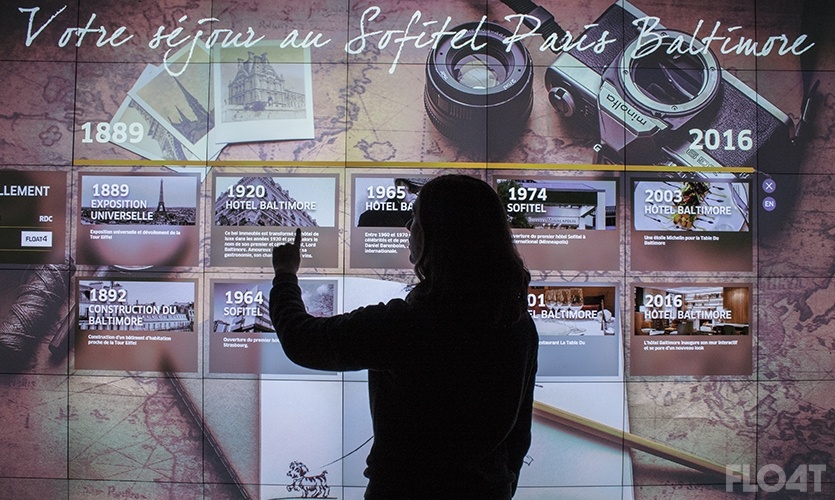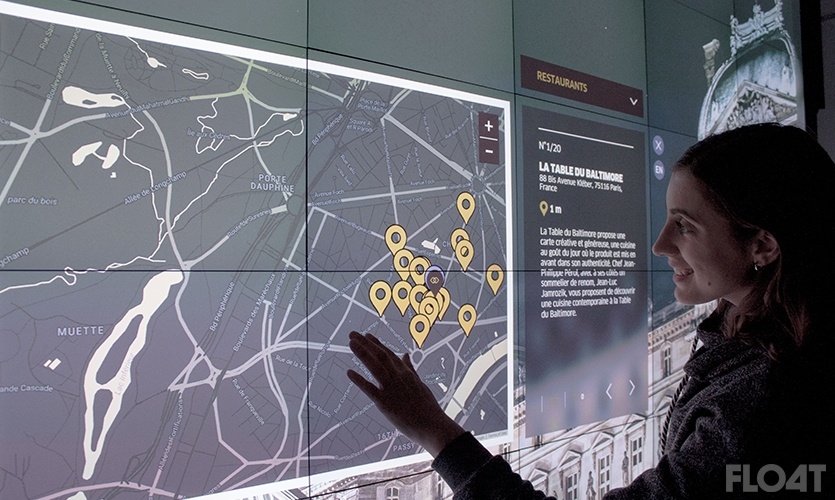
Projects: Paris Hotel’s Interactive Wall Inspired By The City
April 28, 2017 by Dave Haynes
This looks very nice – an experiential video wall in a luxury boutique hotel in Paris that’s ambient, reactive and highly functional when needed.
The Sofitel Paris Baltimore Tour Eiffel worked with Montreal tech agency Float4 on a multi-touch digital welcome wall on the street level designed to help tourist guests connect with the city.
The Float4 team, in planning, put the content focus on Paris. Says an SEGD case study on the project:
They developed a content strategy that was inspired by Parisian landmarks, which would be both useful and engaging for tourists and also incorporated ambient visuals. For the business-oriented, users have access to real-time data such as the stock market, exchange rates and headlines as well as a curated selection of restaurants and shops that can be shared via email. For those who want to explore their creative side, the wall transforms into a digital canvas, allowing guests to engage with drawing and coloring as well as selfie taking with an integrated photo booth feature.

One of the goals was to make it unique by involving the hotel staff. From the concierge to the maître d’hotel, staff members can manage and update content to share their insights on visiting Paris. Beyond complementing the aesthetics of the space, the welcome wall becomes a conduit between the local experience and the guest experience, making stays all the more personal and exclusive.
This multi-pronged content strategy integrating artistic, informational and ambient content would enhance not only the customer’s journey but ease the workload of staff who will shape and evolve the experience over time. The interactive experience also positioned the client as an early adopter in the hotel industry—the first in Paris, or in France—to have an installation of its kind, reflecting the commitment of the establishment to forward, user-centered thinking.
From a design and content standpoint, the Float4 team was inspired by the hotel’s age, interior design, brand guidelines and the idea of the iconic destination. Not only were the user experience and multiple user profiles taken into account, but the aesthetic of the location and, more specifically, the hotel’s design elements. Working within a delicate and ornate environment required finesse; the team created an exact replica of the installation in the studio to perform user testing with multiple groups of adults and children that fit the target audience. “This type of testing is so very useful to us, because we know how important it is to observe people’s first reaction,” says Alexandre Simonescu, co-founder of Float4.
The high-resolution multi-touch wall was seamlessly integrated into the historic architecture in the heart of the hotel’s lobby, across from the bar and elevators—a high-traffic area. One of the challenges they faced was to conceal all the components behind the installation, ensuring a state-of-the-art end-user experience. “We had a fairly small area in which to execute this, where a section of wall needed to be removed and noise control was a concern,” remarks Simonescu. “We constructed a custom framework that went around the media wall that perfectly matched the surrounding décor, creating a seamless transition.” The décor of the surrounding room was a heavy influence on the digital elements as well.

While deliberately understated, the technology is an element of distinction. It was important to maintain a reactive and fluid user experience, while also ensuring high performance standards. The combination of motion tracking, multi-touch capability, a resolution of 6K and real-time generative content make this welcome wall stand out from similar installations. Float4 used technology from the video game industry, including real-time rendered 3-D and complex physical simulations through their proprietary RealMotion server. Web-based technology was used for the menus and content navigation and the custom CMS they developed for ease of content curation by hotel staff.
The artistic, interactive, entertainment and informative content was developed in a dozen capsules. Some capability was pulled in from external data sources, such as weather and stock market information. Float4 also partnered with GoFindIt, a mobile solutions supplier, to provide data relating to travel, hotels and restaurants that is presented in real time. Users can activate the wall by simply walking past the motion sensors, triggering a real-time generation of ambient art, or by touching the wall. For example, within two taps, visitors can navigate to send a two-hour sightseeing itinerary, uploaded by hotel staff, to their mobile phone.
It doesn’t say, but I’m just about certain those are Christie MicroTiles used as the display canvas, which makes some sense, as Float4 has been using that tech since it was launched back in 2009/10.



Leave a comment